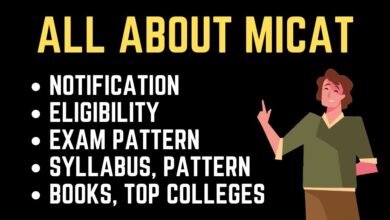How to get through MICA GE-PI | A Complete Guide
MICA GE PI Experience and Expert Tips
This article will help you understand the selection process of Mudra Institute of Communications Ahmedabad (MICA) and exclusive tips are mentioned at the end
YOUR INTRODUCTION
I am Saumya Shivhare. I graduated from NIT Bhopal, Btech ECE. I have two years of work experience in Decision Sciences and consulting. My work experience grew a huge passion for business problem-solving in me. Having done numerous projects in marketing analytics, BI and operations, I realized that this base will surely help me fulfil the bigger dreams. I wanted to invest in myself even more and follow a guided path towards my goal of becoming a seasoned leader.
I left my job in October 2018, with a mission in my heart to pursue post-graduation. With only one and a half month in hand for CAT, SNAP, XAT, MICAT and TISS, I just threw myself into self-studies. I managed to get respectable scores in all of them, got decent calls and to my surprise, converted each one of them.
Calls Converted
Following are my converts (couldn’t attend all of the calls I got)
TISS Mumbai HRM and LR
MICA PGDM-C
VgSOM, IIT Kharagpur
IMT Ghaziabad
IMI Delhi
TAPMI PGDM and BKFS
SIOM Nashik
FORE Delhi
LBSIM Delhi
SITM Pune
MICA GE-PI Experience
I have always been a person more on the creative side. Writing, painting and acting Street plays have been my bread and butter.
When it comes to MICA, it is one of the best institutes for pursuing a degree in communication, strategic marketing and brand management. The institute calls itself ‘School of Ideas’. It marks its territory as one of the most creative places in the industry.
After getting a scaled score of 64.52 in MICAT, and clearing the psychometric and the dreadful Descriptive section of the test, well, I was kinda pseudo-proud. Getting a call from the one college you want to be in, always gives goosebumps.
However, this was just the beginning of my preparation for getting a little closer to a seat in MICA.
And soon I realized, the preparation of the process was summed up in a single line- ‘There is no preparation!’ MICA GE-PI process is one of the most unpredictable and unique processes. They want creativity, out-of-the-box way of thinking, planning and execution. They want to see you express, act, draw, paint, cut, stick, fill colors, do skits, make instant presentations, do an ad campaign, make election manifesto, design a physical game for blind children, sell refrigerator in south pole, advertise the clubs at MICA, justify who should be thrown out of all the GE members are on board a ship!
The list is endless and crazy. One just cannot fathom enough to get mere close to what gets you in.
To tackle this huge unpredictability and variety, I decided to join online groups of call-getters like me, on WhatsApp. With only 8-9 days in my hand, I had got to prepare for the biggest calls- TISS and MICA, whose interviews were back to back.
The previous interview experiences helped me to get thoughts running in my system. I knew myself much better than ever. The only thing that was needed was to bring my brain in the MICA zone (as well as TISS :D)
Every night, one of us would bring a problem statement, and we would allot 30 minutes for ourselves to come to a conclusion. This daily practice for 8 days helped my grey cells start thinking on the fly. Every night I would try my best to get better than the previous night. I broke the limits of my creative thinking and came up with the craziest wildest ideas with each problem statement.
For the interview, well, there is only one way, to know me completely. I always kept thinking about myself, my aspirations, my past, my present and my visualized future. Interviews could go anywhere. To me, interviews are like street plays, where I would have to get on the ground and speak my thoughts clear, concise and honest, unfiltered truth. Of course, there was a profile form we had to fill up, which had SOP, likes/dislikes and general information about my academics and career.
On the D-Day, GE was yet another great one for me. I led it, I painted the posters, I presented my political party as a president, I thought out loud with my GE mates, collaborated with them on each step. It was fun.
But the fun was short-lived when it came to my interview, which was the last one for the day.
I wasn’t asked even a single question from my profile form. They just kept asking me business problems, marketing case studies. There were no cliched interview questions. It was a grilling session, where I was interrupted every 3 minutes. I tackled the case studies and their roasting questions as honestly as I could. My art of problem solving and knowledge of analytics came to my rescue. They were interested in knowing my aspirations and future plans, which I explained to them and got counter-questioned.
I wouldn’t say my interview was smooth, it was rather very rough and sweating. But I knew this was coming. And my hypothesis was right! If I had not done my analysis beforehand, I wouldn’t have made it through. Knowing myself completely, was the key to my success.
I actually have written my autobiography, from the moment I was born, till now. This technique of writing my life was my preparation for converting my calls. I guess, interviewers like people who are done and dusted with themselves.
I wasn’t sure of my conversion as my immediate feeling after the interview was not good. It was bad. I don’t like to be grilled. But the result day was one of the happiest days for me in recent times, where I made it in the first list of MICA PGDM-C.
My apprehensions about my performances came to an end. I could now say that yes, whatever I thought, is somewhat right.
MICA GE-PI TIPS
Tips? Well, there is only one tip for GE-PI process, just know yourself, and play on your strengths. There is no book or guide to success. But the only reference material is your own life.
Write it. Know it. And speak it every day. People like to hear from you when you make it worth to listen to.
Know about your institute, know about its curriculum, activities, advantage, its place in the industry. After this, make a connection of it with your aspirations and future plans. Once you get a story out, recite it, practice it every day. Success will be yours.
Author – Saumya Shivhare
Must Explore




Very well done
Congrates
Well written article. Congratulations!
This is kinda inspiring and very helpful!
Very brief and good explanation ?